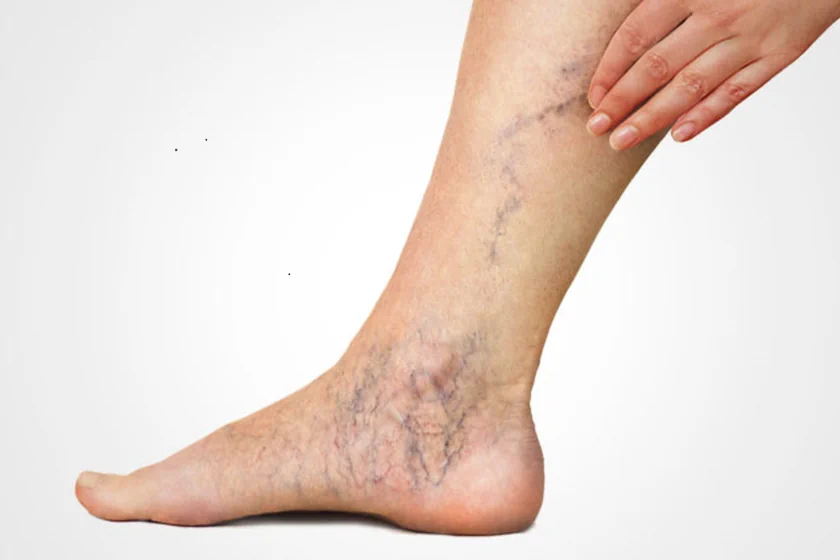
In today’s busy world, where people are always on the move, there’s a common struggle for those who spend a lot of time standing up.
Think of nurses in hospitals, cashiers at stores, or construction workers on site – they all face the risk of getting varicose veins due to obstructed blood circulation. These swollen and twisted veins can cause pain and other health problems if ignored.
But don’t worry!
There are easy things you can do to protect yourself if you’re on your feet all day. By following some simple tips, you can keep varicose veins at bay and feel better while you work. Let’s check out some helpful ideas to keep your legs healthy and happy, even during long shifts.
Understanding The Problem: Varicose Veins
Varicose veins are a common condition that affects many individuals, especially those who spend long hours standing. These enlarged, twisted veins can be painful and unsightly, causing discomfort and embarrassment for those affected. Understanding the underlying varicose vein causes and potential repercussions of varicose veins is crucial for prevention and treatment.
Standing for extended periods of time can lead to increased pressure on the veins in the legs, resulting in poor circulation and the development of varicose veins along with several other vein diseases in legs.
This condition can cause symptoms such as pain, swelling, and aching in the legs, making it difficult to carry out daily activities comfortably.
Tips for Varicose Vein Prevention
Here are some tailored tips for varicose vein prevention, particularly beneficial for those who stand for extended periods:
1. Proper Footwear Selection:
The significance of footwear cannot be overstated for individuals who spend prolonged periods on their feet. Choosing shoes that provide adequate support is crucial for maintaining healthy blood circulation and preventing varicose veins.
Opting for footwear with low heels helps to distribute weight more evenly across the foot, reducing strain on the veins. Additionally, shoes with good arch support can help maintain the natural curvature of the foot, preventing excessive pronation or supination, which can impair blood flow.
Ample room for the toes is also essential to prevent constriction of blood vessels. When selecting shoes, prioritize comfort and support over style to minimize the risk of developing varicose veins.
2. Regular Leg Exercises and Stretching:
Incorporating regular leg exercises and stretching routines into daily activities is essential for individuals who stand for extended periods. These exercises help to strengthen the muscles in the legs, improving overall blood circulation and reducing the strain on the veins.
Calf raises, for example, target the muscles in the lower legs, promoting venous return and preventing blood from pooling in the veins. Ankle circles and leg stretches help to improve flexibility and range of motion, further enhancing blood flow.
Also read – Best Workouts for blood Circulation
By incorporating these simple exercises into their daily routine, individuals can alleviate the pressure on their veins and lower their risk of developing varicose veins.
3. Maintaining Healthy Body Weight:
Maintaining a healthy body weight is crucial for individuals who stand for long periods, as excess weight can exacerbate vein problems and hinder blood circulation. Obesity is a significant risk factor for varicose veins, as it places additional strain on the veins in the legs, making it harder for blood to circulate effectively.
By adopting a balanced diet and engaging in regular physical activity, individuals can achieve and maintain a healthy weight, reducing pressure on their veins and lowering their risk of developing varicose veins.
Incorporating plenty of fruits, vegetables, lean proteins, and whole grains into their diet can provide essential nutrients that support overall vascular health. Read more here – 10 Offbeat Foods That Can Boost Your Vascular Health
4. Taking Regular Breaks and Elevating Legs:
Taking regular breaks to rest and elevate the legs is essential for individuals who stand for extended periods. Prolonged standing can cause blood to pool in the veins, leading to discomfort and swelling.
By taking breaks to sit or lie down and elevating the legs above heart level, individuals can promote venous return and reduce swelling and discomfort associated with varicose veins.
Elevating the legs allows gravity to assist in returning blood to the heart, improving circulation and reducing the risk of developing varicose veins. Aim to take short breaks every hour to give your legs a chance to rest and recover.
5. Using Compression Stockings:
Compression stockings are a highly effective preventive measure for individuals who stand for extended periods. These specially designed garments apply gentle pressure to the legs, helping to improve blood circulation and prevent blood pooling in the veins.
Compression stockings come in various strengths and lengths, and they can be worn throughout the day to alleviate discomfort and reduce the risk of developing varicose veins.
By providing external support to the veins, compression stockings help to reduce swelling, alleviate leg pain, and promote overall vascular health. Consult with a healthcare professional to determine the appropriate compression level and fit for your needs.
Read more about How Compression Stockings Can Help with Varicose Veins?
6. Practicing Good Posture and Ergonomics:
Maintaining good posture while standing is essential for preventing varicose veins and reducing strain on the veins in the legs. Poor posture can impair blood flow and contribute to vein problems over time.
To maintain good posture, stand tall with your shoulders back and relaxed, and distribute your weight evenly between your feet. Avoid locking your knees or slouching forward, as this can restrict blood flow and increase the risk of varicose veins.
Using ergonomic furniture, such as standing desks or anti-fatigue mats, can also help alleviate strain on the legs and promote better posture. Take regular posture breaks throughout the day to stretch and readjust your position, further reducing the risk of varicose veins.
7. Staying Hydrated and Eating a Balanced Diet:
Proper hydration and nutrition are essential for maintaining healthy blood circulation and preventing varicose veins. Drinking plenty of water throughout the day helps to keep blood vessels hydrated and supports optimal blood flow.
Aim to drink at least eight glasses of water per day, and limit your intake of caffeinated and alcoholic beverages, as these can contribute to dehydration. In addition to staying hydrated, eating a balanced diet rich in fiber, vitamins, and minerals is crucial for vascular health.
Incorporate plenty of fruits, vegetables, whole grains, and lean proteins into your diet to provide essential nutrients that support blood circulation and overall vascular function.
Avoid excessive consumption of processed foods, sugary snacks, and unhealthy fats, as these can contribute to inflammation and impair blood flow. By prioritizing hydration and nutrition, individuals can support healthy blood circulation and reduce their risk of developing varicose veins.
Seeking Medical Advice and Treatment Options
Seeking medical advice and exploring treatment options are essential steps for individuals experiencing discomfort or complications related to varicose veins. A consultation with a healthcare professional, such as a vascular surgeon, can provide personalized recommendations based on the severity of the condition and individual health factors.
For individuals with mild varicose veins or those seeking preventive measures, conservative treatments may be recommended.
This may include lifestyle modifications such as wearing compression stockings, engaging in regular exercise, maintaining a healthy weight, and practicing good posture and ergonomics. These measures can help alleviate symptoms and prevent the progression of varicose veins.
In cases where varicose veins cause significant discomfort or complications, medical interventions may be necessary.
Varicose vein surgery, also known as vein stripping or ligation, involves removing or closing off the affected veins to redirect blood flow to healthier veins. This procedure is typically reserved for severe cases of varicose veins and may require a period of recovery.
Laser treatment, also known as endovenous laser ablation (EVLA) or endovenous laser therapy (EVLT), is a minimally invasive procedure that uses laser energy to seal off varicose veins. This technique is often preferred for its effectiveness and shorter recovery time compared to traditional surgery.
The cost of laser treatment for varicose veins can vary depending on factors such as the number of veins treated, the severity of the condition, and the healthcare provider’s location. It’s essential to consult with a vein specialist to discuss treatment options and obtain a personalized cost estimate. (Can link a previous blog about the cost of varicose vein surgery over here)
Ultimately, seeking medical advice and exploring treatment options are crucial steps for managing varicose veins and improving vascular health. By working closely with a healthcare professional, individuals can develop a comprehensive treatment plan tailored to their needs and goals, helping them to alleviate symptoms, reduce complications, and enhance their overall well-being.
FAQs
Yes, standing for long periods can contribute to the development of varicose veins by increasing pressure on the veins, impairing circulation, and causing blood pooling.
Yes, celebrities can have varicose veins like anyone else. However, they may have access to cosmetic treatments or procedures to address them, which may not always be visible to the public eye.
Nurses prevent varicose veins by wearing supportive footwear, taking regular breaks to rest and elevate their legs, engaging in physical activity, and wearing compression stockings.
Compression stockings can help alleviate symptoms and reduce the risk of varicose veins for people who stand all day by promoting blood flow and preventing blood pooling in the legs.
Yes, practicing good posture can help workers with varicose veins by reducing pressure on the veins, improving circulation, and alleviating discomfort associated with prolonged standing.
Final Note
In summary, varicose veins pose significant discomfort and potential health risks, especially for those who stand for prolonged periods.
However, proactive measures like selecting appropriate footwear, engaging in regular exercise, maintaining a healthy weight, taking breaks, utilizing compression stockings, maintaining good posture, and staying hydrated can significantly reduce the likelihood of developing varicose veins and promote overall vascular health.
Should you experience discomfort or seek treatment options, seeking professional medical advice is paramount. Dr. Sumit Kapadia, a distinguished vascular surgeon in Vadodara, specializing in varicose vein treatments, offers tailored solutions and expert guidance to address varicose vein concerns effectively.

MBBS, MS, MRCS, DNB-Fellow
Dr. Sumit Kapadia
Dr. Sumit Kapadia / MR KAPADIA SUMIT a gold-medalist from Baroda Medical College, obtained his general surgical training and senior residency from SSG Hospital, Vadodara.

MBBS, MS, MRCS, DNB-Fellow
Dr. Sumit Kapadia
Dr. Sumit Kapadia / MR KAPADIA SUMIT a gold-medalist from Baroda Medical College, obtained his general surgical training and senior residency from SSG Hospital, Vadodara.



